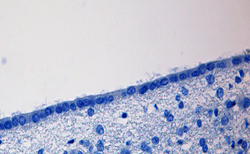Theependymais the thinneuroepithelial(simple columnar ciliated epithelium) lining of theventricular systemof thebrainand thecentral canalof thespinal cord.[1]The ependyma is one of the four types ofneurogliain thecentral nervous system(CNS). It is involved in the production ofcerebrospinal fluid(CSF), and is shown to serve as a reservoir forneuroregeneration.
| Ependyma | |
|---|---|
 | |
 Photomicrograph of normal ependymal cells at 400× magnification in human autopsy tissue | |
| Identifiers | |
| MeSH | D004805 |
| TA98 | A14.1.00.022 |
| TA2 | 5368 |
| FMA | 242791 |
| Anatomical terminology | |
Structure
editThe ependyma is made up of ependymalcellscalled ependymocytes, a type ofglial cell.These cells line theventricles in the brainand thecentral canalof the spinal cord, which become filled withcerebrospinal fluid.These arenervous tissuecells with simple columnar shape, much like that of some mucosal epithelial cells.[2]Early monociliated ependymal cells are differentiated to multiciliated ependymal cells for their function in circulating cerebrospinal fluid.[3]
Thebasal membranesof these cells are characterized by tentacle-like extensions that attach toastrocytes.The apical side is covered in cilia and microvilli.[4]
Function
editCerebrospinal fluid
editLining the CSF-filledventricles,and spinal canal, the ependymal cells play an important role in the production and regulation of CSF. Theirapical surfacesare covered in a layer ofcilia,which circulate CSF around the CNS.[4]Their apical surfaces are also covered withmicrovilli,which absorb CSF. Within the ventricles of the brain, a population of modified ependymal cells and capillaries together known as thetela choroideaform a structure called thechoroid plexus,which produces the CSF.[5]
Modifiedtight junctionsbetween epithelial cells control fluid release. This release allows free exchange between CSF and nervous tissue of brain and spinal cord. This is why sampling of CSF, such as through aspinal tap,provides information about the whole CNS.
Neuroregeneration
editJonas Frisén and his colleagues at theKarolinska InstituteinStockholmprovided evidence that ependymal cells act as reservoir cells in the forebrain, which can be activated after stroke and as in vivo and in vitro stem cells in the spinal cord. However, these cells did not self-renew and were subsequently depleted as they generated new neurons, thus failing to satisfy the requirement for stem cells.[6][7]One study observed that ependymal cells from the lining of thelateral ventriclemight be a source for cells which can be transplanted into thecochleato reverse hearing loss.[8]
Clinical significance
editEpendymomais atumorof the ependymal cells most commonly found in thefourth ventricle.
See also
editReferences
edit- ^"ependyma".The Free Dictionary.
- ^Histology, a text in atlas, M. Ross 2011, 6th edition page 367
- ^Kyrousi, C; Lygerou, Z; Taraviras, S (July 2017). "How a radial glial cell decides to become a multiciliated ependymal cell".Glia.65(7): 1032–1042.doi:10.1002/glia.23118.PMID28168763.S2CID3770948.
- ^abBrat, Daniel J. (2010-01-01), Perry, Arie; Brat, Daniel J. (eds.),"2 - Normal Brain Histopathology",Practical Surgical Neuropathology,New York: Churchill Livingstone, pp. 15–33,ISBN978-0-443-06982-6,retrieved2021-01-06
- ^Sadler, T. (2010).Langman's medical embryology(11th ed.). Philadelphia: Lippincott William & Wilkins. p. 305.ISBN978-0-7817-9069-7.
- ^Johansson CB, Momma S, Clarke DL, Risling M, Lendahl U, Frisen J (1999)."Identification of a neural stem cell in the adult mammalian central nervous system".Cell.96(1): 25–34.doi:10.1016/S0092-8674(00)80956-3.PMID9989494.S2CID9658786.
- ^Carlén M, Meletis K, Göritz C, Darsalia V, Evergren E, Tanigaki K, Amendola M, Barnabé-Heider F, Yeung MS, Naldini L, Honjo T, Kokaia Z, Shupliakov O, Cassidy RM, Lindvall O, Frisén J (2009). "Forebrain ependymal cells are Notch-dependent and generate neuroblasts and astrocytes after stroke".Nature Neuroscience.12(3): 259–267.doi:10.1038/nn.2268.PMID19234458.S2CID10479458.
- ^"Brain cell hope for hearing loss".BBC News.2008-12-09.Retrieved2008-12-09.